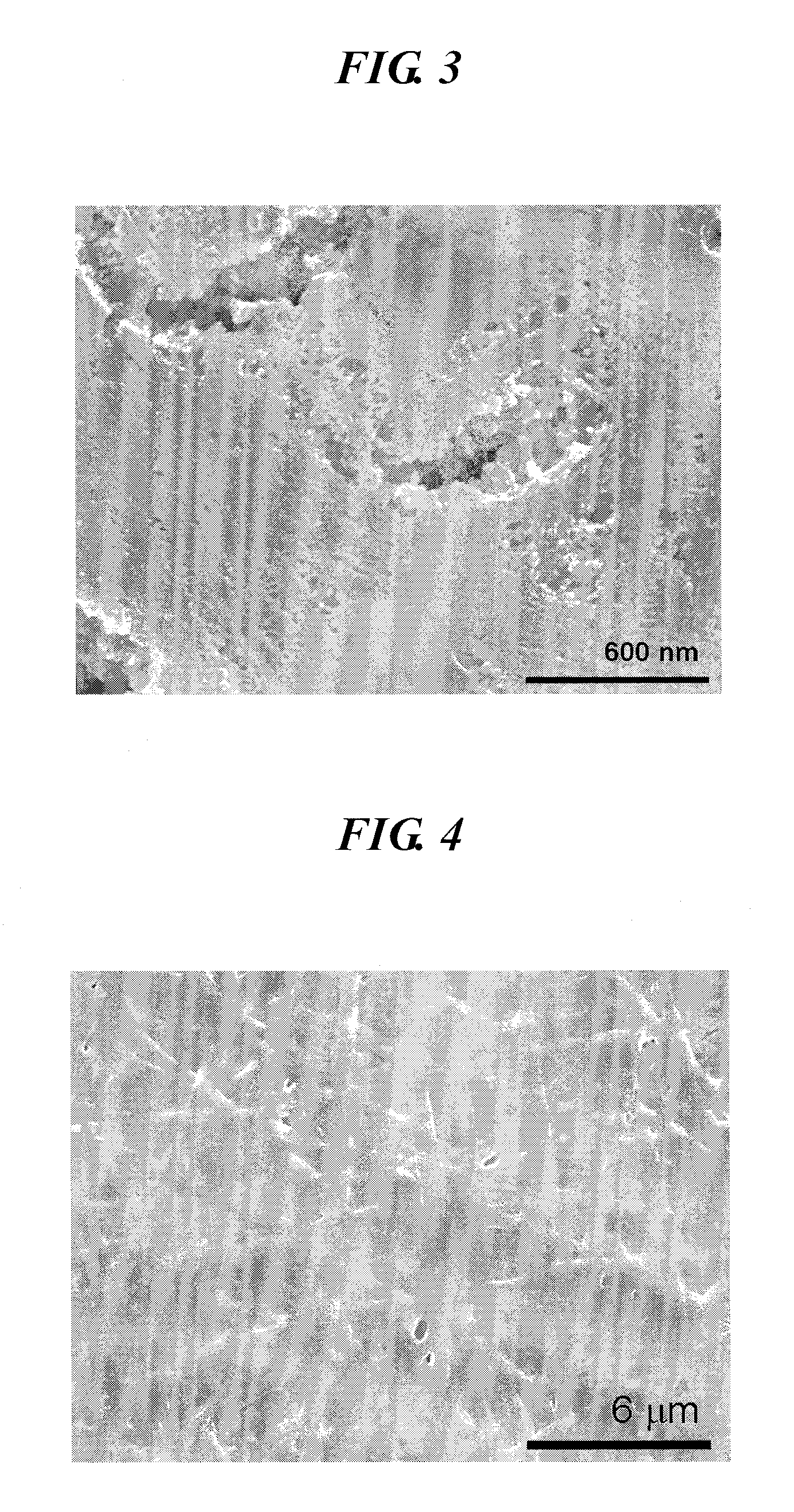Electrode for supercapacitor having manganese oxide-conductive metal oxide composite layer, fabrication method thereof, and supercapacitor comprising same
a supercapacitor and composite layer technology, applied in the direction of electrical apparatus, inorganic chemistry, domestic applications, etc., can solve the problems of limiting the commercialization affecting the performance affecting the long-term life stability and cycle characteristics of such a supercapacitor, etc., to achieve excellent specific capacitance, excellent specific capacitance, mechanical stability, thermal stability
- Summary
- Abstract
- Description
- Claims
- Application Information
AI Technical Summary
Benefits of technology
Problems solved by technology
Method used
Image
Examples
example 1
Fabrication of Electrode
[0070]0.84 g of manganese (III) acetylacetonate (Mw=352.27, Aldrich) and 0.49 g of ruthenium chloride (Mw=207.43) were placed in a 100 mL round bottomed flask. 10 g of dimethyl formamide (DMF, J. T. Baker) was added thereto until they were completely dissolved, and 0.67 mL of acetic acid was added to the resulting solution to facilitate subsequent electrospinning. The mixture thus obtained was stirred for about 1 min and was dissolved in 1.6 g of polyvinyl acetate (PVAc, Mw=500,000) while stirring 2 hr to prepare a spinning solution containing the manganese oxide precursor, ruthenium oxide precursor, and PVAc. A small amount of cetyltrimethylammonium bromide was added to the spinning solution to facilitate the subsequent electrospinning.
[0071]The spinning solution thus obtained was loaded in a 20 mL syringe and injected the surface of a current collector at a rate of 10 μl / min using a 30 G needle while maintaining a potential difference of about 13-15 kV, to ...
example 2
Fabrication of Electrode
[0077]The ultrafine fiber web formed in Example 1 was pressed using a laminator (60° C., 0.1 MPa, 60 sec) and annealed at 300° C. for 1 hr to fabricate an electrode including a manganese oxide-ruthenium oxide nanoparticle network.
[0078]The pressing pressure and time are factors that change the surface structure of the electrode. Further, the thermal pressing or thermal pressurization temperature was determined depending on the glass transition temperature of the polymer. Particularly, the size of the nanoparticles was easily controlled by varying the secondary annealing temperature.
[0079]FIG. 4 is an SEM image (magnification 5,000×) taken after the thermal pressing of the ultrafine fiber web of Example 1.
[0080]As shown in FIG. 4, the PVAc having a low glass transition temperature was completely melted, and as a result, the nanofibers were entirely connected to one another.
[0081]FIG. 5 is an SEM image (magnification 10,000×) of the porous composite metal oxide...
experimental example 1
Electrochemical Characterization
[0086]The electrochemical properties of the electrode fabricated in Example 1 as an electrode for a supercapacitor were evaluated.
[0087]Cyclic voltammetry is a method that can be used to measure the capacitive behavior of an electrode for a supercapacitor. A good electrode for a supercapacitor shows a high current density and a symmetric profile from left to right like a rectangle in both anodic and cathodic sweeps in the cyclic voltammogram (CV). The electrochemical properties of the electrode were evaluated based on a three-electrode electrochemical measurement. The potential of a saturated calomel electrode (SCE) was in the range of 0 to 1.0 V and the scan rate was from 10 to 2,000 mV / s. 0.1-1 M Na2SO4 solution was used as an electrolyte and the manganese oxide-ruthenium oxide nanofiber web was used as a working electrode. Ag / AgCl electrode was used as a reference electrode and platinum (Pt) was used as a counter electrode. The supercapacitive prop...
PUM
| Property | Measurement | Unit |
|---|---|---|
| Temperature | aaaaa | aaaaa |
| Temperature | aaaaa | aaaaa |
| Diameter | aaaaa | aaaaa |
Abstract
Description
Claims
Application Information
 Login to View More
Login to View More - R&D
- Intellectual Property
- Life Sciences
- Materials
- Tech Scout
- Unparalleled Data Quality
- Higher Quality Content
- 60% Fewer Hallucinations
Browse by: Latest US Patents, China's latest patents, Technical Efficacy Thesaurus, Application Domain, Technology Topic, Popular Technical Reports.
© 2025 PatSnap. All rights reserved.Legal|Privacy policy|Modern Slavery Act Transparency Statement|Sitemap|About US| Contact US: help@patsnap.com



